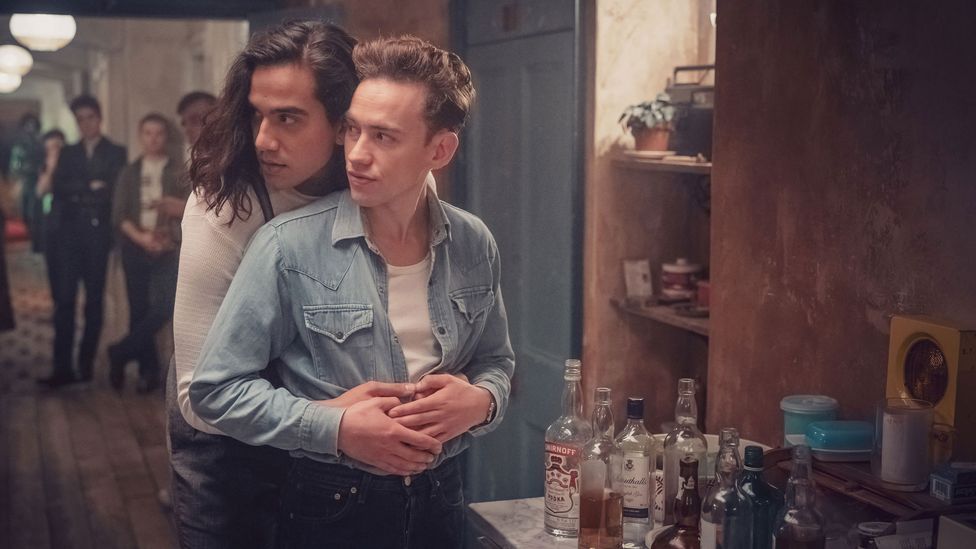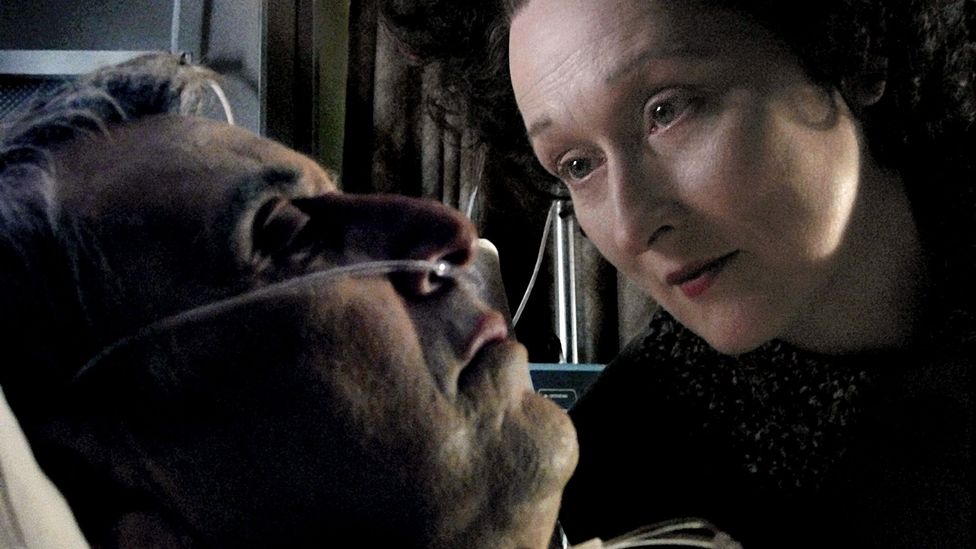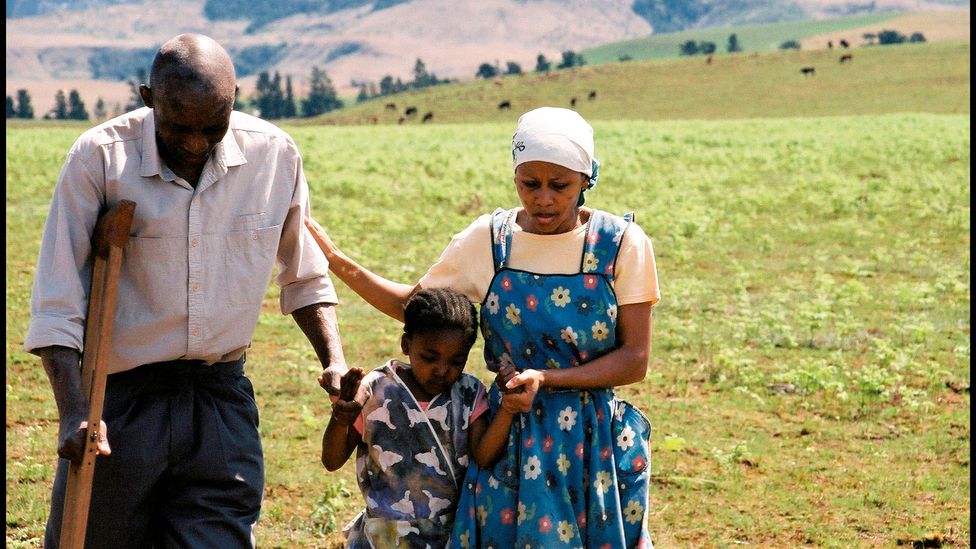It's 1983, and a bookish 20-year-old stands in his local newsagents, flicking through the magazine rack. The shop is in Oxford, amid a quiet suburb of red-and-grey brick terraced houses, a half-mile or so's walk from Oxford University's Worcester College, where he has studied for the past two years. He feigns exaggerated interest in a few periodicals and glossies, but he’s there, really, for a single purpose – to buy the latest copy of monthly gay magazine Him. Why his mission is clandestine needn't be elaborated.
More like this:
– One of the greatest ever TV dramas
– Nine TV shows to watch in January
– The play that raged against Reagan's America
His purchase nervously secured, he retreats outside into a wall of heat. It's a gorgeous, sweltering June day, with a symphony of birdsong carried by the breeze. He wanders down the street, prize in hands. He hadn't dared take the time to look at the magazine in the shop, but now, the coast is clear. The cover is illustrated by the great homoerotic artist Oliver Frey with a picture of men boiling in a test tube, accompanied by a banner that shouts at him from across the page. "AIDS DEATH PLOT PANIC."

It's a Sin tells the story of the UK Aids crisis from the perspective of a group of young gay men coming of age in the 1980s (Credit: Channel 4)
This episode is recalled to me by writer Russell T Davies over Zoom from his flat in Cardiff, Wales. As one might expect of the dramatist behind some of Britain's most acclaimed television series– the eerily prescient Years & Years, the Bafta-nominated A Very English Scandal, the Bafta-winning resurrection of Doctor Who – he paints a vivid image. It's this moment from his own youth that was the spiritual root of his latest series, It's a Sin. "I stood there and thought, 'oh, it's real'," Davies recalls. "But here I am, right, almost 40 years later, writing this entire drama actually about that moment in the street."
The show centres on a commune of five young people, four gay guys and a girl, living together in the 'Pink Palace', a grotty London party house with sticky carpets and flaking wallpaper. It begins in the early 1980s. Having escaped their small-town enclaves for the Big Smoke, they party every night like they've nothing to lose, the sex as copious as the booze. However, looming on the horizon unbeknown to them – but all too obvious to us – is a medical catastrophe: Aids.
The lineage of Aids fiction
Aids fiction has a long and illustrious lineage, with the greatest abundance of (and certainly the most internationally-recognised) works having emerged from the United States, the epicentre of the virus in the 1980s. However, few dramatists have wrestled with it in a British context – and fewer, if any, so extensively as Davies does in It's a Sin. The resonances the series shares with its US screen predecessors, nonetheless, are ever-apparent. Like Norman Rene's 1989 film Longtime Companion or, more recently, Yen Tan's 2018 drama 1985, Davies's series weighs heavily with tragic inevitability. We watch the ensemble live, make mistakes, and indulge the hedonistic desires of their early 20s, as characters in any other youth drama – only with death hanging over them as an ever-present threat. The clock ticks. The virus has no rhyme or reason: someone perishes after sex with a single partner, while others are flabbergasted by negative test results, having exhausted their sexual options in the bars. Every time Ritchie (a spellbinding Olly Alexander) takes a boy home, it's a roll of the dice.
One early montage, in which Ritchie rattles off a list of the then-debated causes of the virus, echoes the great monologue in Larry Kramer's seminal Aids play The Normal Heart, in which the character Mickey, an activist and public health worker, laments the endless theories about the virus's origins ("I've written about every single one of them," he says, exasperated).

Tony Kushner's two-part play Angels in America, filmed for TV with Al Pacino, is one of the totemic US works of Aids fiction (Credit: Alamy)
Ritchie, embodying the pleasure-is-politics ethos of many gay men at the crisis' beginning, is tired, too, of the endless noise, refusing to let his promiscuity, which is his freedom, succumb to paranoia. And like Tony Kushner's Angels in America, the series' sweeping, decade-long timeline gives us a profound sense of how the ensemble is changed. By the end, their youthful vitality is coated with a stubborn frost, sometimes thawed by cups of milky tea and consoling cuddles.
While It's a Sin is the first British series to explore the Aids crisis on a societal level, the virus has echoed through British popular culture since at least the late 80s. The 1987 TV drama Intimate Contact, for example, relayed the impact of an individual Aids diagnosis within a heterosexual marriage. Meanwhile, the first time Davies saw HIV depicted on screen – or rather the suggestion of HIV – was during an infamous 1988 storyline in the country's popular primetime soap opera EastEnders, involving its leading gay character Colin. "They led us on a dance with Colin (Michael Cashman) – he started to fall ill, and the whole country was waiting for him to contract HIV in quite a ghoulish way... it turned out he had MS." The year before, Colin was also a participant in the first gay kiss in a British soap opera. The soaps, like EastEnders, boasted enormous pull with the viewing public at the time, Davies recalls. "[They were] a much more powerful cultural artefact [in those days]. Then, it was the show to look at, the show to give you cues on how to react."
In a subsequent storyline beginning in January 1991 and ending 13 years later with his death from complications of Aids, Mark Fowler (Todd Carty), who was heterosexual and married, contracted the virus. He faced significant prejudice, not least from the show's iconic matriarch, Peggy Mitchell (Barbara Windsor). They eventually reconciled. "For her to learn that she was wrong was a really powerful lesson," says Davies. "Of course, at that stage, they did a very wise thing, which was to say 'look, this isn't affecting just gay people, this is affecting straight people as well'. They ended up telling a very, very powerful story."
The phantom of the virus was also present in Davies' earlier, other explicitly queer works, set after the crisis had begun to abate. His pioneering late-1990s drama Queer as Folk featured a character, Phil, killed by a drug overdose during a hook-up. It may not be literalised as Aids, but gay sex, here, leads to death. Meanwhile 2015's Cucumber, which centres on a group of aging gay men, considered how the memory of Aids lingers for the generation who lived through the crisis at its peak. Their familiarity with queer death is emphasised at the funeral of Lance (Cyril Nri), murdered after sex by a closeted man curdled with shame. "I thought we’d seen the last of this," says Cliff (Con O'Neill), "funerals at too young an age. I thought we'd beaten it". They crack jokes and gawp at Grindr boys as if sat in a bar on Canal Street.
What there is left to add
These days, American, British or otherwise, the very concept of the Aids drama may provoke the question among some: is there anything new to add? That's because works such as The Normal Heart and Angels in America are the monoliths of LGBTQ+ fiction, contributing to perceptions that the epidemic has been dramatically exhausted. "In some ways every gay writer – and you don't have to be gay to write about HIV, of course – stands in the shadow of [those texts]," says Davies. "Because here they are, being revived all the time. They are immense and brilliant." He points to the upcoming revival of The Normal Heart planned at London's National Theatre [as and when coronavirus restrictions lift] and the hit production of Angels in America, that premiered there in 2017 before moving to Broadway. However the flipside of their brilliance is that it's perhaps easier to understand why a more exhaustive rendering of the British crisis has not hitherto emerged. "I was sitting in commissioners' offices saying 'you haven't seen this'," Davies explains of trying to get It's a Sin greenlit, "which is a very hard thing to argue when you're asking for millions of pounds".

2017 French film 120 BPM, about the Paris branch of activist group ACT UP, has been one of the most impactful Aids dramas of recent times (Credit: Alamy)
Davies says his show is consciously interacting with all its forebears while also being distinct from them. "I'm very well versed in Aids fiction. I'm not saying I've seen everything… but I probably have, because it interests me. It's my life," he explains. "I could write an essay about how much of It's a Sin is dancing with other pieces of work, and finding different ways to tell things that have been done before, because I didn't want to repeat. I had things of my own to say that I felt hadn't been said, too."
What's clear is that while the centring of North America in Aids fiction is understandable – given the epidemic there counted for the lion's share of HIV infections and deaths in the West – each country and area of the world has its own important stories to tell, and it is heartening that the canon of Aids fiction continues to grow and extend its global reach.
Stories all over the world
Looking from Britain to Europe, more widely, an especially impactful recent Aids drama was the 2017 French film 120BPM, which told the story of ACT UP Paris, an offshoot of the New York activist group co-founded by Larry Kramer in 1987 (and of which its director, Robin Campillo, was a member). Parts of the film, wherein we observe the activists debating the efficacy of their protest methods, evoke the aesthetic style of cinéma vérité, matching the film's urgency with blunt realism. Again, echoing the established conventions of Aids fiction, it conveys a sense of horrifying inevitability. This isn't the only example of France's epidemic on film, implicit or otherwise: director Paul Vecchiali covered it as far back as 1988's Once More, and an entire thesis could be written on Aids allegories in contemporary French queer film.
Francois Ozon’s recent Summer of ’85, for example, centres on the heady summer fling shared by Alex (Felix Lefebvre) and David (Benjamin Voisin), the latter of whom dies as a result of events put into motion, in part, by his reluctance to commit to monogamy: David has sex with another partner, they fight, and he speeds away on his motorbike, crashing into traffic. The film takes a turn for the absurd at its climax, as Alex dances on David's grave to the sound of Rod Stewart's Sailing, his face contorting with orgasmic pleasure and lovelorn rage. Over in Spain, meanwhile, themes around Aids have dripped through the filmography of beloved auteur Pedro Almodovar, not least in his Oscar-winning All About My Mother, which sees both heterosexual and queer characters ravaged by the virus.
It's also interesting to think how narratives about Aids possess very different contexts in different areas of the world: in East and Southern Africa, the new epicentre of the global HIV pandemic, for example, viral transmission is generalised throughout the population. The region is home to over half of the world's current number of HIV-positive people and, indeed, the virus continues to burn throughout the global south. Key films dealing with the ever-present crisis there have included Darrell Roodt's Yesterday, South Africa's nominee for Best Foreign Language Film in 2004: it follows the story of a young mother, the eponymous Yesterday (Leleti Khumalo), who is diagnosed with Aids after a long illness. (According to HIV/Aids charity Avert, South Africa hosts the worst HIV epidemic in the world, with around one-in-five people infected. In recent years it was the first country in sub-Saharan Africa to fully approve the prophylactic drug, PrEP.)

Darrell Roodt's Yesterday (2004) offered a South African perspective on the pandemic, following a young mother diagnosed with Aids after a long illness. (Credit: Alamy)
When it comes to documentary insights, meanwhile, Dylan Mohan Gray’s scorching 2013 film Fire in the Blood casts light on the villainy of pharmaceutical companies, who have historically outpriced impoverished states and individuals from accessing life-saving antiretroviral (ARV) drugs. The film emphasises how millions continue to die throughout the developing world despite the existence of ARVs which, in the West, mostly render HIV an inconvenience. Conversely, Lance Bang's 2010 documentary short The Lazarus Effect captures the lifesaving potential of ARVs within a small community in Zambia, made available to the population by the tireless work of medical professionals and activists. The victims' skeletal bodies are revitalised in mere weeks. It's a celebration of community and selflessness as much as it is human ingenuity.
We so often look into the past with queer fiction, in part because queer desires, fantasies and romances have been historically forced into the shadows by prejudice, making them a great source of dramatic suspense. Perhaps it can feel like we're rummaging through our attics, lifting tragedies from boxes and bins. This is especially true of Aids fiction, which is often like picking away at the edges of a healing scab. Yet there is still so much to say about the crisis that remains vital, and for all that the canon may be cherished, new stories need to be told from all corners of the Earth.
For even in the current moment, when our planet is engulfed by another plague, our memories are short. "Here's the lesson now, in the midst of another virus," Davies says. "You sit listening to [news] phone-ins, and people of my age are sitting there going: this is the second [major epidemic in the UK in recent years], it's the second! Yet [the first] is barely referenced." There are 33 years between Russell and me, but I feel the same frustration – the broader amnesia towards Aids in the present echoes the ambivalence of the past. It can feel, sometimes, like it never happened.
Thirty-three million people have died of Aids across the globe, and they continue to do so, yet the dominant point of comparison for coronavirus has consistently been the 1918 flu pandemic, from more than a century ago. Why isn't Aids being cross-referenced as much as it should be? "It's the same problem all over again: the shame and fear around talking about sex and the nature of transmission. That's what killed so many people in the 80s, and here it is still now, still prevalent," says Davies. He pauses briefly, a crack in his jolly cadence. "It's amazing, isn't it?"
It's a Sin is currently showing on Channel 4 and All4 in the UK and will air on HBO Max in the US later in 2021.
Love film and TV? Join BBC Culture Film and TV Club on Facebook, a community for cinephiles all over the world.
If you would like to comment on this story or anything else you have seen on BBC Culture, head over to our Facebook page or message us on Twitter.
And if you liked this story, sign up for the weekly bbc.com features newsletter, called The Essential List. A handpicked selection of stories from BBC Future, Culture, Worklife and Travel, delivered to your inbox every Friday.
"story" - Google News
January 22, 2021 at 03:00PM
https://ift.tt/3ochF6z
Aids on screen: the forgotten stories of the other pandemic - BBC News
"story" - Google News
https://ift.tt/2YrOfIK
https://ift.tt/2xwebYA
Bagikan Berita Ini














0 Response to "Aids on screen: the forgotten stories of the other pandemic - BBC News"
Post a Comment